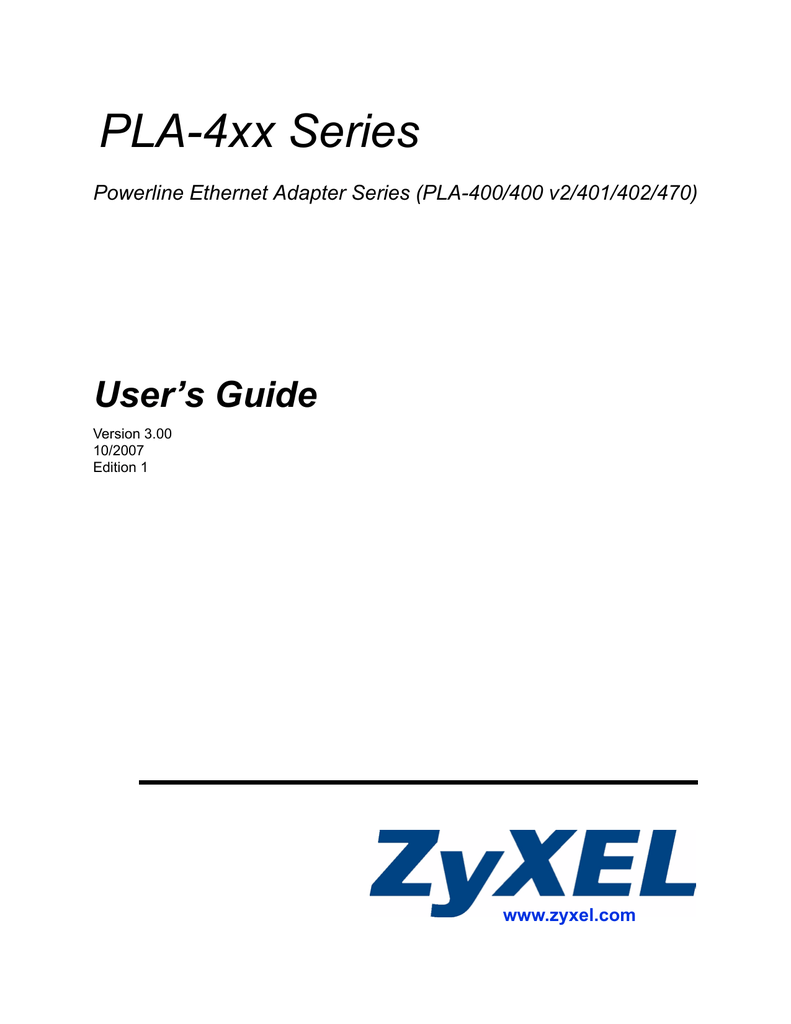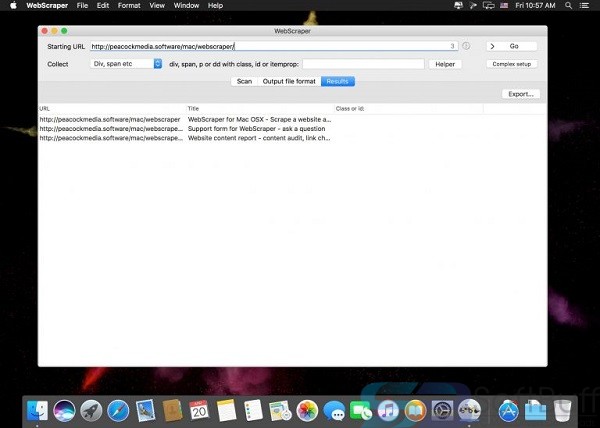What you need to install Windows 10 on Mac
- MacBook introduced in 2015 or later
- MacBook Air introduced in 2012 or later
- MacBook Pro introduced in 2012 or later
- Mac mini introduced in 2012 or later
. Mac OS X 10.7. Mac OS X 10.8 4.2.2 Installing the Utility Follow the steps below to install the ZyXEL PLA Series Configuration utility on your Mac computer. Insert the included CD into your computer’s CD-ROM drive.

- iMac introduced in 2012 or later1
- iMac Pro (all models)
- Mac Pro introduced in 2013 or later
Use the ZyXEL PLA Series Configuration utility (or utility, for short) to manage the PLA. See Chapter 3 on page 21 for instructions on installing the utility. 1.5 Expand Your Network with the PLA The PLA plugs into an ordinary power outlet to easily extend a cable or DSL broadband connection. ZyXEL PLA-4xx Series Configuration Utility is a Commercial software in the category Communications developed by ZyXEL PLA-4xx Series Configuration Utility. The latest version of ZyXEL PLA-4xx Series Configuration Utility is 3.0.5, released on. It was initially added to our database on.
The latest macOS updates, which can include updates to Boot Camp Assistant. You will use Boot Camp Assistant to install Windows 10.
64GB or more free storage space on your Mac startup disk:
- Your Mac can have as little as 64GB of free storage space, but at least 128GB of free storage space provides the best experience. Automatic Windows updates require that much space or more.
- If you have an iMac Pro or Mac Pro with 128GB of memory (RAM) or more, your startup disk needs at least as much free storage space as your Mac has memory.2
An external USB flash drive with a storage capacity of 16GB or more, unless you're using a Mac that doesn't need a flash drive to install Windows.
A 64-bit version of Windows 10 Home or Windows 10 Pro on a disk image (ISO) or other installation media. If installing Windows on your Mac for the first time, this must be a full version of Windows, not an upgrade.
- If your copy of Windows came on a USB flash drive, or you have a Windows product key and no installation disc, download a Windows 10 disk image from Microsoft.
- If your copy of Windows came on a DVD, you might need to create a disk image of that DVD.
How to install Windows 10 on Mac
To install Windows, use Boot Camp Assistant, which is included with your Mac.
1. Check your Secure Boot setting
Learn how to check your Secure Boot setting. The default Secure Boot setting is Full Security. If you changed it to No Security, change it back to Full Security before installing Windows. After installing Windows, you can use any Secure Boot setting without affecting your ability to start up from Windows.
2. Use Boot Camp Assistant to create a Windows partition
Open Boot Camp Assistant, which is in the Utilities folder of your Applications folder. Follow the on-screen instructions.
- If you're asked to insert a USB drive, plug your USB flash drive into your Mac. Boot Camp Assistant will use it to create a bootable USB drive for Windows installation.
- When Boot Camp Assistant asks you to set the size of the Windows partition, remember the minimum storage-space requirements in the previous section. Set a partition size that meets your needs, because you can't change its size later.
3. Format the Windows (BOOTCAMP) partition
When Boot Camp Assistant finishes, your Mac restarts to the Windows installer. If the installer asks where to install Windows, select the BOOTCAMP partition and click Format. In most cases, the installer selects and formats the BOOTCAMP partition automatically.
4. Install Windows
Unplug any external devices that aren't necessary during installation. Then click Next and follow the onscreen instructions to begin installing Windows.
5. Use the Boot Camp installer in Windows
After Windows installation completes, your Mac starts up in Windows and opens a ”Welcome to the Boot Camp installer” window. Follow the onscreen instructions to install Boot Camp and Windows support software (drivers). You will be asked to restart when done.
- If the Boot Camp installer never opens, open the Boot Camp installer manually and use it to complete Boot Camp installation.
- If you have an external display connected to a Thunderbolt 3 port on your Mac, the display will be blank (black, grey or blue) for up to 2 minutes during installation.
How to switch between Windows and macOS
Restart, then press and hold the Option (or Alt) ⌥ key during startup to switch between Windows and macOS.
Learn more
If you have one of these Intel-based Mac models using OS X El Capitan or later, you don't need a USB flash drive to install Windows:
- MacBook introduced in 2015 or later
- MacBook Air introduced in 2017 or later3
- MacBook Pro introduced in 2015 or later3
- iMac introduced in 2015 or later
- iMac Pro (all models)
- Mac Pro introduced in late 2013 or later
To remove Windows from your Mac, use Boot Camp Assistant, not any other utility.
For more information about using Windows on your Mac, open Boot Camp Assistant and click the Open Boot Camp Help button.
1. If you're using an iMac (Retina 5K, 27-inch, Late 2014) or iMac (27-inch, Late 2013) or iMac (27-inch, Late 2012) with a 3TB hard drive and macOS Mojave or later, learn about an alert you might see during installation.
2. For example, if your Mac has 128GB of memory, its startup disk must have at least 128GB of storage space available for Windows. To see how much memory your Mac has, choose Apple menu > About This Mac. To see how much storage space is available, click the Storage tab in the same window.
3. These Mac models were offered with 128GB hard drives as an option. Apple recommends 256GB or larger hard drives so that you can create a Boot Camp partition of at least 128GB.
Objective
An Access Control List (ACL) is a collection of permit and deny conditions, called rules, that provide security and block unauthorized users and allow authorized users to access specific resources. The ACL can block any unwarranted attempts to reach network resources. MAC ACL is a Layer 2 ACL. The network device inspects the frame and checks the ACL rules against the content of the frame such as the source and destination MAC address. If any of the rules match the content, a permit or deny action is taken on the frame.
This article explains how to create and configure MAC ACL on WAP121 and WAP321 Access Points (WAP).
Applicable Devices
• WAP121
• WAP321
Software Version
• v1.0.3.4
Creation of MAC based ACL

Step 1. Log in to the Access Point Configuration Utility and choose Client QoS > ACL. The ACL page opens:
Creation of a MAC based ACL
Step 1. Enter the name of the ACL in the ACL Name field.
Step 2. Choose MAC for the ACL type from the ACL Type drop-down list.
Step 3. Click Add ACL to create a new MAC ACL.
Configuration of a Rule for MAC based ACL
Step 1. Choose the desired ACL from the ACL Name - ACL Type drop-down list.
Step 2. If a new rule has to be configured for the selected ACL, choose New Rule from the Rule drop-down list; otherwise, choose one of the present rules from the Rule drop-down list.
Note: A maximum of 10 rules can be created for a single ACL.
Step 3. Choose the action for the ACL rule from the Action drop-down list.
• Deny — Blocks all traffic that meets the rule criteria to enter or exit the WAP device.
• Permit — Allows all traffic that meets the rule criteria to enter or exit the WAP device.
Note: Steps 4 to 11 are optional. Filters that are checked are enabled. Uncheck the check box for the filter if you do not want it to apply to this specific rule.
Step 4. Check the Match Every Packet check box to match the rule for every frame or packet regardless of its contents. Uncheck the Match Every Packet check box to configure any of the additional match criteria.
Timesaver: If Match Every Packet is checked then skip to Step 12.

Step 5. Check the EtherType check box to compare the match criteria against the value in the header of an Ethernet frame. If EtherType check box is checked, click one of these radio buttons.
• Select From List — Choose a protocol from the drop-down list. The drop-down list has appletalk, arp, ipv4, ipv6, ipx, netbios, pppoe.
• Match to Value — For the custom protocol identifier. Enter the identifier which ranges from 0600 to FFFF.
Step 6. Check the Class of Service check box to enter 802.1p user priority to compare against an Ethernet frame. Enter the priority which ranges from 0 to 7 in the Class of Service field.
Step 7. Check the Source MAC Address check box to compare the source MAC address against an Ethernet frame and enter the source MAC address in the Source MAC Address field.
Step 8. Enter the source MAC address mask in the Source MAC Mask field that specifies which bits in the source MAC to compare against an Ethernet frame. If the MAC mask uses a 0 bit, then the address is accepted, and if it uses 1 bit, then the address is ignored.
Step 9. Check the Destination MAC Address check box to compare destination MAC address against an Ethernet frame and enter the destination MAC address in the Destination MAC Address field.
Step 10. Enter the destination MAC address mask in the Destination MAC Mask field that specifies which bits in the destination MAC to compare against an Ethernet frame. If the MAC mask uses a 0 bit, then the address is accepted, and if it uses a 1 bit, then the address is ignored.

Pla Configuration Utility For Mac Catalina
Step 11. Check the VLAN ID check box to compare the VLAN ID against an Ethernet frame. Enter the VLAN ID which ranges from 0 to 4095 in the VLAN ID field.
Note: For information on how to create a new VLAN, refer the article Configuration of Management and Untagged VLAN IDs on WAP121 and WAP321.
Pla Configuration Utility For Mac Download
Step 12. Click Save to save the settings.
Step 13. (Optional) To delete the configured ACL, check the Delete ACL check box and then click Save.
